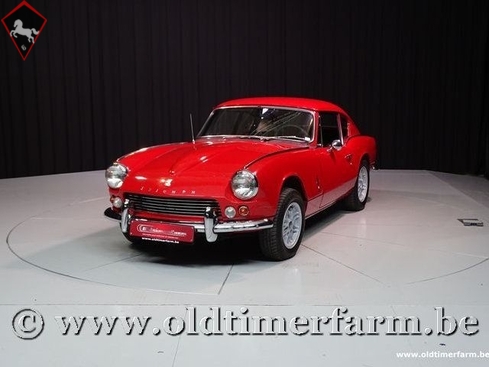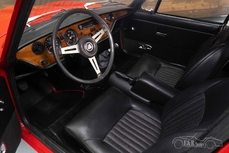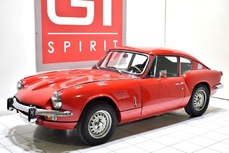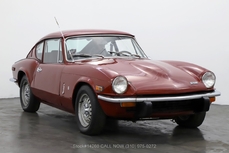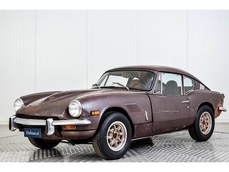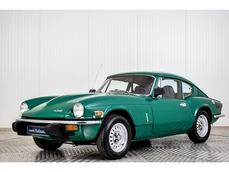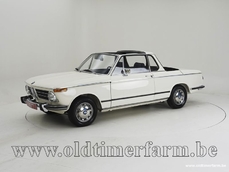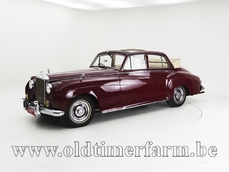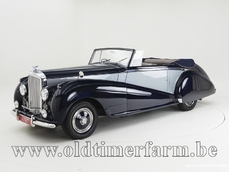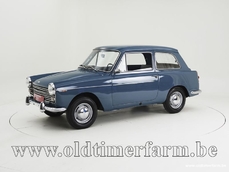Triumph GT-6 MKI '68 1968
Allgemeine Beschreibung :
Belgian papers
Owners manual
Spare parts catalog
Engine and gear box fully revised
Body re-coated in 1997
Older restoration but the car is in good condition
The GT6 is a 6-cylinder sports coupé which was built by Standard-Triumph and based on their popular Triumph Spitfire convertible. Production ran from 1966 to 1973.
In early 1963 Giovanni Michelotti was commissioned by Standard-Triumph to design a GT version of their recently introduced Spitfire 4 (also designed by Michelotti). An unmodified Spitfire 4 was transported to Michelotti's design studios in Italy and late in 1963 the prototype Spitfire GT4 was returned to England for evaluation. The styling of the vehicle was a success but unfortunately the extra weight of the GT bodyshell resulted in extremely poor performance, with the 1,147 cc (70 cu in) Spitfire power unit, and plans for producing the Spitfire GT4 were shelved. However, Michelotti's fastback design for the Spitfire GT4 prototype was (for the 1964 season) adopted by the Triumph racing-programme as it was deemed to provide an aerodynamic benefit over the standard Spitfire body-shape. Fibreglass copies of the Spitfire GT4's fastback were grafted on to the race-modified Spitfires destined for competition. The Spitfire racing programme was successful and, in 1965, resulted in 13th overall and a 1st in class at the prestigious 24 Hours of Le Mans (beating their main rivals, the MG Midgets). The Spitfire's competitive success and the continuing commercial success of the production vehicle led Triumph to re-evaluate its shelved plans for a GT version of the Spitfire. To overcome the lack of performance inherent in the heavier body-style the Spitfire's 4-cylinder engine was replaced with the more powerful 2-litre (1,998 cc) 6-cylinder engine from the Triumph Vitesse (which shared a similar chassis with the Spitfire and Triumph Herald). The car was further developed and refined and eventually launched as the Triumph GT6 (dropping the "Spitfire" prefix) to identify its GT styling and its 6-cylinder engine.
Contemporary Triumph marketing advertised the GT6 as being developed from the "race winning Le Mans Spitfires" to capitalize on their aesthetic similarities, whereas the Le Mans Spitfires and the GT6 were actually two entirely separate development programmes (the GT programme pre-dating the racing programme). However, the marketing spin was so successful that many people erroneously believed the Le Mans Spitfires to actually be GT6s.
The new car was introduced in 1966 and called the Triumph GT6. The new body was a sleek fastback design with an opening rear hatch (This gave the GT6 the nickname "Poor man's E-Type".) It was really a 2-seater, but a small extra rear seat could be ordered if required and was large enough for small children. The family resemblance to the Spitfire Mk II was strong, the longer 6-cylinder engine necessitated a new bonnet top with a power bulge and the doors were provided with opening quarter light windows and squared-off glass in the top rear corner. The 6-cylinder engine was tuned to develop 95 bhp (71 kW) at 5000 rpm, and produced 117 lb·ft (159 N·m) of torque at 3000 rpm. The increased power necessitated certain changes to the Spitfire mechanics; the radiator was new and mounted further forward in the car and the gearbox was the stronger unit from the Vitesse, with optional overdrive. Front springs were uprated to cope with the extra weight from the new engine. The overall vehicle weight unladed was 1,904 lb (864 kg). The interior of the GT6 was well equipped; a wooden dashboard housed a full complement of instruments, with carpets and heater included as standard.
The new car had some very strong selling points. The new engine provided a 106 mph (171 km/h) top speed and 0–60 mph in 12 seconds, a little better than the MGB GT. Moreover, the unit was comparatively smooth and tractable, in marked contrast to the MG's rather harsh 4-cylinder motor. Fuel economy was very reasonable for the period at 20mpg, and the interior well up to the competition. The only major criticism was of its rear suspension; the GT6 inherited the swing-axle system from the Spitfire, which in turn was copied from the Herald small saloon. In the saloon it was tolerated, in the little Spitfire it was not liked and in the powerful GT6 it was heavily criticised. Triumph had done nothing to improve the system for the GT6 and the tendency to break away if the driver lifted off the power mid-corner was not helped at all by the increased weight at the front of the car. The handling was most bitterly criticised in the USA, an important export market for Triumph, where they were traditionally very strong. Similar criticism was being levelled at the Vitesse saloon, which shared the GT6's engine and its handling problems.
Specifications
Bodywork
Length : cm (in): 368 (145)
Width : cm (in): 145 (57)
Height : cm (in): 119 (47)
Wheelbase : cm (in) : 211 (83)
Weight: kg (lb) : 860 (1898)
Mechanics.
Displacement : straight-six 1998 cc, front-mounted
Valve gear : 12
Fuel system : 1 carburettor
Gearbox : 4 speed, manual
Driven wheels : rear-wheel drive
Maximum power : 95 bhp at 5000 rpm
Maximum torque : 158 Nm at 3000 rpm
Top speed : 174 km/h (109 mph)
http://www.oldtimerfarm.be/en/collection-cars-for-sale/3875/triumph-gt6-mki-68.php
1968 Triumph GT-6 MKI '68 is listed verkauft on ClassicDigest in Aalter by Oldtimerfarm Dealer for €18950.
Fakten der Auto
Karosserietyp : Auto Marke : Triumph Modell : GT-6 Ausführung : MKI '68 Hubraum : 0.0 Modelljahr : 1968 Karosstyp : Coupé Lage : Aalter
Verkauft
Angaben Zum Verkäufer
Verkauft
People who viewed this Triumph GT-6 also viewed similar Triumph listed at ClassicDigest
Other cars listed for sale by this dealer
über Triumph
Triumph, ein Name, der mit klassischen Sportwagen und innovativen Designs synonym ist, hat eine reiche und bewegte Geschichte in der Automobilwelt.Die Geschichte von Triumph begann im späten 19. Jahrhundert, als das Unternehmen zunächst Fahrräder produzierte und dann in die Motorradherstellung expandierte. Es war jedoch in den 1920er Jahren, dass Triumph in die Produktion von Automobilen einstieg. Im Laufe der Jahre wurde Triumph für seine hochwertigen Fahrzeuge bekannt, die Leistung mit Stil kombinierten.
Eines der ikonischsten Modelle von Triumph war der TR3, der Ende der 1950er Jahre eingeführt wurde. Es war ein klassischer britischer Sportwagen, geliebt für sein einfaches, aber elegantes Design und ein aufregendes Fahrerlebnis. Der TR3 war ein Symbol für bezahlbaren Sportwagen-Genuss und legte den Grundstein für eine Reihe erfolgreicher TR-Modelle, darunter der TR4, TR5 und TR6.
Neben den Sportwagen machte sich Triumph einen Namen mit von Michelotti entworfenen Limousinen. Der Triumph Herald, Anfang der 1960er Jahre eingeführt, war ein kompaktes Familienauto, das mit stilvollem Design und solider Technik punktete. Später bediente der Triumph 2000 und 2500 Limousinen einen gehobeneren Markt und erlangte einen Ruf für ihren komfortablen Fahrkomfort und ihr elegantes Aussehen.
Trotz seiner Erfolge sah sich Triumph im Laufe der Jahre zahlreichen Herausforderungen gegenüber, darunter finanzielle Schwierigkeiten und Eigentümerwechsel. In den 1980er Jahren durchlief die British Leyland, das Unternehmen, das Triumph besaß, eine umfassende Umstrukturierung, und die Marke Triumph wurde allmählich eingestellt.
Das Verschwinden der Marke Triumph war in der Tat traurig und in gewissem Maße beschämend. Das Unternehmen, das geliebte Sportwagen und angesehene Limousinen produziert hatte, verschwand langsam. Im Jahr 1984 rollte das letzte Fahrzeug mit dem Triumph-Logo von der Produktionslinie und markierte das Ende einer Ära.
Obwohl der Name Triumph verschwand, lebt sein Erbe weiter. Enthusiasten und Sammler schätzen weiterhin klassische Triumph-Sportwagen wie den TR3, TR6 und Spitfire sowie den einzigartigen Charme von Triumph-Limousinen. Triumph bleibt ein Symbol für das britische Automobilerbe und die anhaltende Faszination für klassische Sportwagen.
Zusammenfassend ist die Geschichte von Triumph eine Mischung aus klassischer Sportwagen-Exzellenz und innovativem Limousinen-Design. Sein trauriger und beschämender Niedergang erinnert an die Herausforderungen, denen viele Automobilhersteller im Laufe der Jahre gegenüberstanden, aber der Geist von Triumph lebt in den Herzen von Automobil-Enthusiasten auf der ganzen Welt weiter. Und der TR3 bleibt ein leuchtendes Beispiel für die großartigen Eigenschaften und die zeitlose Faszination klassischer Sportwagen.
